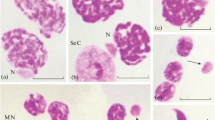Abstract
A method is described to restrict the spermatocyte population in mice and other rodents using hydroxyurea (HU) and triaziquone (T). HU affects cells in S-phase, whereas T is an agent especially active on spermatogonia and not on spermatocytes. An application of three i.p. HU injections with 12 h intervals, followed about nine days later by one i.p. T injection creates two large gaps in the spermatogenic line. The two gaps enclose a small, well-defined group of primary spermatocytes in meiotic interphase. — The development of the restricted spermatocyte population is followed day by day. The analysis of meiosis in male mice has revealed the correct sequence of meiotic, and especially prophase I stages. On account of clearly visible differences in chromosome morphology the diplotene stage could be divided into three periods. It is suggested to use the following nomenclature: pre-diffuse diplotene, diffuse diplotene and post-diffuse diplotene. The experiment was also informative about the timing of the stages in spermatocyte development by correlating the days at which the successive stages were observed with the corresponding stage of the epithelial cycle. The calculation of the position and duration of the diffuse diplotene, enables us to put forward a proposal about the significance of the diffuse diplotene. — A combination of the HU/T method with cell separation techniques provides good perspectives for detailed biochemical studies on processes taking place during meiosis.
Similar content being viewed by others
References
Church, K.: Meiosis in the grasshopper. II. The preleptotene spiral stage during oogenesis and spermatogenesis in Melanopus femur-rubrum. Canad. J. Genet. Cytol. 14, 397–401 (1972)
Grimes, S.R., Chi-bom Chae, J.R., Logan Irvin, J.: Acetylation of histones of rat testis. Arch. Biochem. Biophys. 168, 425–435 (1975)
Huckins, C.: The spermatogonial stem cell population in adult rats. I. Their morphology, proliferation and mutaration. Anat. Rec. 169, 533–558 (1971)
Klasterska, I.: The concept of the prophase of meiosis. Hereditas (Lund) 86, 205–210 (1977 a)
Klasterska, L, Natarajan, A.T., Ramel, C.: A highly radiation-sensitive stage in the late prophase of mouse spermatocyte meiosis. Hereditas (Lund) 87, 99–106 (1977 b)
Léon, P.E.: Function of lampbrush chromosomes: a hypothesis. J. theor. Biol. 55, 481–490 (1975)
Moens, P.B.: A new interpretation of meiotic prophase in Lycopersicon esculentum (Tomato). Chromosoma (Berl.) 15, 231–242 (1964)
Monesi, V.: Autoradiographic study of DNA synthesis and the cell cycle in spermatogonia and spermatocytes of mouse testes, using tritiated thymidine. J. Cell Biol. 14, 1–18 (1962)
Monesi, V.: Chromosome activities during meiosis and spermatogenesis. J. Reprod. Fertil., Suppl. 13, 1–14 (1971)
Nadler, K.D.: Histone acetylation during meiosis in Lilium microsporocytes. Exp. Cell Res. 101, 283–292 (1976)
Parvinen, M., Vanha-Perttula, T.: Identification and enzyme quantitation of the stages of the seminiferous epithelial wave in the rat. Anat. Rec. 174, 435–450 (1972)
Pfeiffer, S.E., Tolmach, L.J.: Inhibition of DNA synthesis in HeLa cells by hydroxyurea. Cancer Res. 27, 124–129 (1967)
Oakberg, E.F.: A description of spermatogenesis in the mouse and its use in analysis of the cycle of the seminiferous epithelium and germ cell renewal. Amer. J. Anat. 99, 391–409 (1956 a)
Oakberg, E.F.: Duration of spermatogenesis in the mouse and timing of stages of the cycle of the seminiferous epithelium. Amer. J. Anat. 99, 507–516 (1956 b)
Oakberg, E.F.: Spermatogonial stem cell renewal in the mouse. Anat. Rec. 169, 515–532 (1971)
Oud, J.L., Peters, P.W.J.: A sequential screening of the cytogenetic damage induced by triaziquone. Mutation Res. 54, 175–184 (1978)
Rooij, D.G. de: Spermatogonial stem cell renewal in the mouse. I. Normal situation. Cell Tissue Kinet. 6, 281–287 (1973)
Sinclair, K.K.: Hydroxyurea: effect on Chinese hamster cells grown in culture. Cancer Res. 27, 297–308 (1967)
Stahl, A., Luciani, J.M., Devictor-Vuillet, M.: Étude chromosomique de la méiose. In: Les accidents chromosomiques de la reproduction (A. Boué and C. Thibault, eds.), pp. 197–218. Paris: INSERM 1973
Walters, M.S.: Evidence on the time of chromosome pairing from the preleptotene spiral stage in Lilium longiflorum “Croft”. Chromosoma (Berl.) 29, 375–418 (1970)
Wilson, E.B.: The cell in development and heredity, 3d ed. New York: Macmillan, 1925
Author information
Authors and Affiliations
Rights and permissions
About this article
Cite this article
Oud, J.L., de Jong, J.H. & de Rooij, D.G. A sequential analysis of meiosis in the male mouse using a restricted spermatocyte population obtained by a hydroxyurea/triaziquone treatment. Chromosoma 71, 237–248 (1979). https://doi.org/10.1007/BF00292826
Received:
Accepted:
Issue Date:
DOI: https://doi.org/10.1007/BF00292826




